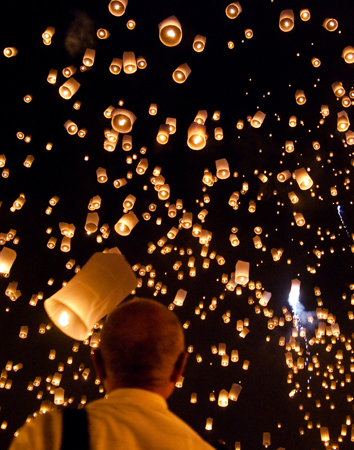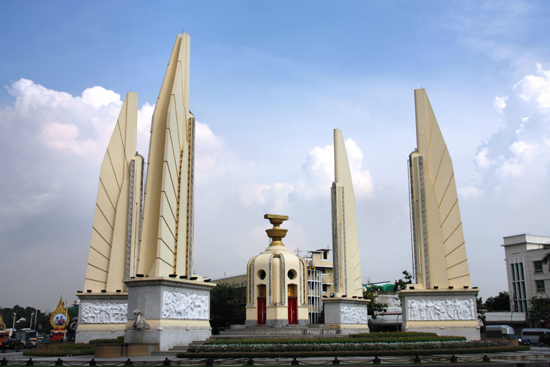Country Snapshot: Country Snapshot
Land/Geography/Regions
Located in the center of mainland Southeast Asia, tropical Thailand covers 513,120 square kilometers (198,120 square miles). It shares borders with Myanmar, Laos, Cambodia, and Malaysia with coastline along the Gulf of Thailand and the Andaman Sea.
Thailand’s landscape features a central plain, a mountainous northern region, and an upland plateau. The central plain is drained by the Chao Phraya River and its tributaries, which empty into the Bay of Bangkok. The Khorat Plateau in northeast Thailand is made up of low rolling hills and shallow lakes. It drains into the Mun River, a tributary of the Mekong that empties into the South China Sea. The north’s Thanon Thong Chai mountain range is home to the country’s highest peak, Doi Inthanon, at 2,565 meters (8,415 feet).
People and Culture
Ethnic Thai comprise the majority of the population, who are thought to originate in the southern Chinese province of Yunnan. The largest minority group in Thailand are Chinese, while several indigenous groups who mainly originate from South Asia make up the rest of the population.
Central Thai, also called Siamese Thai, is the official language of Thailand. Almost the entire country speaks a variant of the Thai language, with regional dialects including Pak Thai in the south, Isan Thai in the northeast, and Lanna Thai in the north.
The majority of the country’s citizens practice Buddhism, with some incorporating aspects of Hinduism. Theravada Buddhism and Hinduism were introduced to Thailand by the Mon people, some of the earliest inhabitants of the region, between the 6th and 11th centuries. Islam and Christianity are also practiced on a small scale.
Thai people value family, friends, community, and good food. They are known as friendly and easy-going, with a modest and respectful nature. Popular recreational activities include kickboxing, called muay Thai, and a form of shadow play known as nang yai, while Thai chess— known as makruk—and Thai dance are also important to the culture.
History
Inhabited for more than half a million years and a center of bronze metallurgy by 4000 BCE, the region now known as Thailand saw several kingdoms over the centuries before the major Thai kingdoms were established during the 13th century. In 1767, the Thai Kingdom of Ayutthaya was overthrown by invading Burmese armies, and a new dynasty was established at the site of present-day Bangkok. The only Southeast Asian country never conquered by a European power, Thailand oriented its foreign policy principally toward China and neighboring countries until the 19th century. The country established formal and friendly relations with the United Kingdom and the United States in the 1820s and ‘30s.
Thailand transitioned from an absolute to a constitutional monarchy in 1932, and nearly five decades of military governments interspersed with brief periods of democracy followed. During World War II, Japan occupied Thailand until being defeated in 1945. Thailand sent troops to Korea in 1954 and fought alongside the US in the Vietnam War during the second half of the 20th century.
The rise of democratic political institutions began in the 1970s and 80s, though the end of the 20th century also saw coups, military rule, and violent suppression of opposing political groups. The beginnings of the 21st century saw Thailand dealing with issues including corruption, limited press freedoms, and election boycotts. In the south, thousands died during violent separatist movements while conflict between the major political parties persisted. A military coup and the removal of the country’s prime minister occurred in 2014, and after 70 years as Thailand's monarch, the country’s king died in 2016.
Climate and Biodiversity
The climate of Thailand is tropical with high humidity and an average temperature of 30 degrees Celsius (86 degrees Fahrenheit). The warmest months are from March to May, with April being the hottest. The country’s annual monsoon season brings heavy rain from May or June until October, although in the south, the rainy season typically lasts until December.
Thailand has a wealth of biodiversity, supporting thousands of plants and animals. These include nearly 15,000 plant species including teak, varieties of bamboo, ferns, coconut palms, banana plants, and tropical fruit trees. Over 1,000 kinds of orchids are found in Thailand, with native flower species including the lotus—an important religious symbol in the country—along with frangipani, jasmine, hibiscus, and the whiskery bat flower.
The country has hundreds of kinds of mammals, freshwater fish, and reptiles, while 1,000 bird species and 160 amphibian species also call the country home. Distinctive wildlife includes the Irrawaddy dolphins, Indochinese tigers, Asian black bears, monitor lizards, Asian elephants, macaques, and clouded leopards.
Economy
Thailand’s economy is one of the largest in southeast Asia and in the top 10 for all of Asia. It boasts one of the lowest unemployment rates in the world due to much of the population supporting themselves through subsistence agriculture. The Thai baht is one of Asia’s strongest performing currencies. The top-earning sectors of Thailand’s economy are industrial and service with automobiles and tourism among the country’s largest industries.
Additional though less significant contributions come from trade and logistics, communication, agriculture, as well as construction and mining. Thailand’s economy depends heavily on exports, which account for more than two-thirds of its gross domestic product (GDP). The top export is machinery including computers and electrical equipment followed by vehicles, rubber, and plastics.
Government
Thailand operates as a constitutional monarchy, and Bangkok serves as the country’s capital. A hereditary monarch is head of state, mostly taking part in ceremonial roles. The prime minister, appointed by the monarch, is head of government and nominates a Council of Ministers, which is then formally appointed by the monarch. The council is responsible for overseeing and administering the day-to-day functions of state. In addition to being chair of the Council of Ministers, the prime minister also serves as leader of the House of Representatives. He or she may serve for as long as they hold the confidence of the House, up to an eight-year limit. The bicameral National Assembly (Rathhasapha) is the lawmaking authority composed of a Senate (Wuthissapha) and House of Representatives (Saphaphuthan Ratsadon). Thailand’s highest judicial bodies are the Supreme Court, Constitutional Court, and Supreme Administrative Court.
Article written for World Trade Press by Brielle Burt and Alex Colgan.
Copyright © 1993—2025 World Trade Press. All rights reserved.

 Thailand
Thailand 


